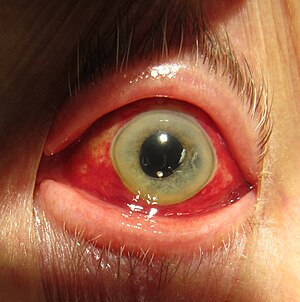Subconjunctival hemorrhage
| Subconjunctival hemorrhage | |
|---|---|
 |
|
| Subconjunctival hemorrhage causing red coloration as result of ruptured blood vessel in the eye. | |
| Classification and external resources | |
| Specialty | Ophthalmology |
| ICD-10 | H11.3 |
| ICD-9-CM | 372.72 |
| MedlinePlus | 001616 |
| eMedicine | oph/270 |
| Patient UK | Subconjunctival hemorrhage |
Subconjunctival hemorrhage, also known as subconjunctival haemorrhage and hyposphagma, is bleeding underneath the conjunctiva. The conjunctiva contains many small, fragile blood vessels that are easily ruptured or broken. When this happens, blood leaks into the space between the conjunctiva and sclera.
Such a hemorrhage may be caused by a sudden or severe sneeze or cough, or due to hypertension or as a side effect of blood thinners. It may also be caused by heavy lifting, vomiting, or even rubbing one's eyes too roughly. In other cases, it may result from being choked or from straining due to constipation. Also, it can result as a minor post-operative complication in eye surgeries such as LASIK.
Whereas a bruise typically appears black or blue underneath the skin, a subconjunctival hemorrhage initially appears bright-red underneath the transparent conjunctiva. Later, the hemorrhage may spread and become green or yellow, like a bruise. Usually this disappears within 2 weeks.
Although its appearance may be alarming, in general a subconjunctival hemorrhage is a painless and harmless condition; however, it may be associated with high blood pressure, trauma to the eye, or a base of skull fracture if there is no posterior border of the hemorrhage visible.
Subconjunctival hemorrhages in infants may be associated with scurvy (a vitamin C deficiency),abuse or traumatic asphyxia syndrome.
A subconjunctival hemorrhage is typically a self-limiting condition that requires no treatment in the absence of infection or significant trauma. The elective use of aspirin and NSAIDs is typically discouraged. Artificial tears may be applied four to six times a day.
...
Wikipedia
